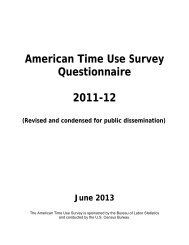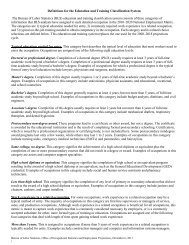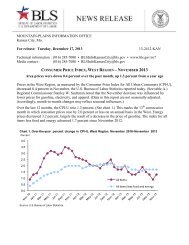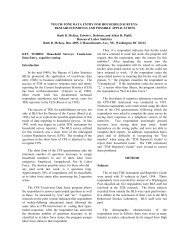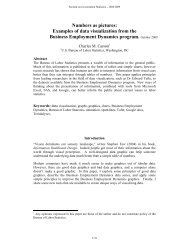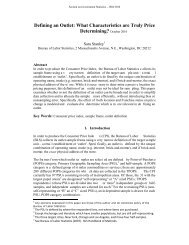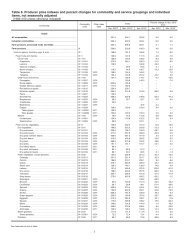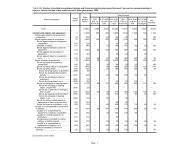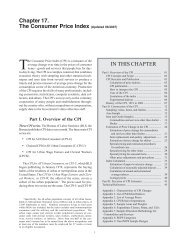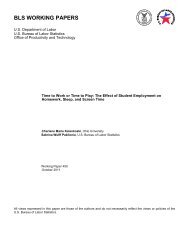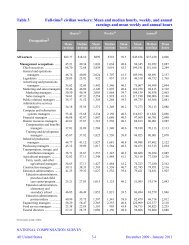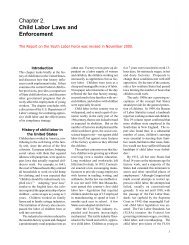Household spending by single persons and married couples in their ...
Household spending by single persons and married couples in their ...
Household spending by single persons and married couples in their ...
Create successful ePaper yourself
Turn your PDF publications into a flip-book with our unique Google optimized e-Paper software.
Data <strong>and</strong> methods<br />
Interview survey. The data for this article<br />
are from the 2007–08 Interview<br />
Survey component of the CE. The Interview<br />
Survey conta<strong>in</strong>s <strong>in</strong>formation<br />
on <strong>in</strong>comes, expenditures, <strong>and</strong> demographic<br />
characteristics of American<br />
consumers, collected quarterly from<br />
a nationally representative sample of<br />
CUs <strong>in</strong> the U.S. population.<br />
The CE <strong>in</strong>cludes two components:<br />
the quarterly Interview Survey <strong>and</strong><br />
the weekly Diary Survey. Published<br />
CE tables are created <strong>by</strong> <strong>in</strong>tegrat<strong>in</strong>g<br />
<strong>in</strong>formation from the two surveys.<br />
The Interview Survey, which is designed<br />
to collect data on major types<br />
of expenditures, household characteristics,<br />
<strong>and</strong> <strong>in</strong>come, is used <strong>in</strong> this study<br />
because it provides the most complete<br />
picture of <strong>spend<strong>in</strong>g</strong>. Respondents are<br />
usually asked to report values for<br />
expenditures or outlays that occurred<br />
dur<strong>in</strong>g the three months prior to the<br />
<strong>in</strong>terview. The data <strong>in</strong> this analysis<br />
are <strong>by</strong> collection year, not calendar<br />
year, from CUs <strong>in</strong>terviewed <strong>in</strong> 2007<br />
<strong>and</strong> 2008. This study employs many<br />
of the methods set forth <strong>in</strong> Paul<strong>in</strong>’s<br />
article.<br />
Outlays. The analysis that follows<br />
uses outlays, as opposed to expenditures,<br />
for comparisons. Outlays are<br />
similar to expenditures <strong>in</strong> that both<br />
measures (1) def<strong>in</strong>e <strong>spend<strong>in</strong>g</strong> as the<br />
transaction cost, <strong>in</strong>clud<strong>in</strong>g taxes, to<br />
obta<strong>in</strong> goods <strong>and</strong> services, (2) <strong>in</strong>clude<br />
<strong>spend<strong>in</strong>g</strong> on gifts for people outside<br />
of the CU, <strong>and</strong> (3) exclude bus<strong>in</strong>ess<br />
expenses. The key difference is <strong>in</strong><br />
the treatment of purchases of real<br />
property <strong>and</strong> vehicles. In the CE, expenditures<br />
on purchases of property<br />
<strong>in</strong>clude only mortgage <strong>in</strong>terest <strong>and</strong><br />
expenditures on vehicles <strong>in</strong>clude the<br />
full value of the purchased vehicle,<br />
regardless of whether it was or was<br />
not f<strong>in</strong>anced. By contrast, outlays<br />
<strong>in</strong>clude both the pr<strong>in</strong>cipal <strong>and</strong> <strong>in</strong>terest<br />
portions of property on mortgages<br />
<strong>and</strong> vehicle loans. The purchase price<br />
of vehicles bought outright <strong>and</strong> not<br />
f<strong>in</strong>anced also is <strong>in</strong>cluded <strong>in</strong> outlays.<br />
Weights. The CE uses a representative<br />
sample to estimate the <strong>spend<strong>in</strong>g</strong> habits<br />
of the U.S. civilian non<strong>in</strong>stitutional<br />
population. Estimates shown <strong>in</strong> this<br />
article are calculated with the use of<br />
weights. For the 2007–08 Interview<br />
Survey, approximately 600 <strong>married</strong><br />
CUs <strong>and</strong> 2,200 <strong>s<strong>in</strong>gle</strong> CUs provided<br />
data for this analysis. These sampled<br />
CUs represent nearly 7 million CUs<br />
<strong>in</strong> the population.<br />
Reference groups. Recogniz<strong>in</strong>g that<br />
21- to 29-year-olds are not a homogeneous<br />
group <strong>and</strong> that the twenties<br />
are a period of lifestyle transition,<br />
the analysis exam<strong>in</strong>es three dist<strong>in</strong>ct<br />
groups: those CUs (with reference<br />
person) ages 21 to 23 years, those <strong>in</strong><br />
<strong>their</strong> midtwenties (24 to 26 years),<br />
<strong>and</strong> those <strong>in</strong> <strong>their</strong> late twenties (27 to<br />
29 years). Further restrictions on the<br />
age difference between spouses <strong>in</strong> a<br />
<strong>married</strong>-couple CU follow.<br />
Consumers must be <strong>s<strong>in</strong>gle</strong> or <strong>married</strong><br />
with no children <strong>in</strong> order to be<br />
<strong>in</strong>cluded <strong>in</strong> the analysis. To be categorized<br />
as a “<strong>s<strong>in</strong>gle</strong>” CU, a person must<br />
identify him- or herself as <strong>s<strong>in</strong>gle</strong> <strong>and</strong><br />
never <strong>married</strong> <strong>and</strong> must be <strong>in</strong> a CU<br />
of size 1. This categorization implies<br />
that the person is not liv<strong>in</strong>g with<br />
other blood relatives, is not widowed<br />
or divorced, <strong>and</strong>, if there are other<br />
people liv<strong>in</strong>g <strong>in</strong> the hous<strong>in</strong>g unit, is<br />
f<strong>in</strong>ancially <strong>in</strong>dependent (that is, is<br />
not mak<strong>in</strong>g jo<strong>in</strong>t f<strong>in</strong>ancial decisions<br />
with his or her housemates). F<strong>in</strong>ancial<br />
<strong>in</strong>dependence is determ<strong>in</strong>ed <strong>by</strong><br />
the three major expense categories:<br />
hous<strong>in</strong>g, food, <strong>and</strong> other liv<strong>in</strong>g expenses.<br />
To be considered f<strong>in</strong>ancially<br />
<strong>in</strong>dependent, the respondent must<br />
pay all or part of the consumer unit’s<br />
expenses <strong>in</strong> at least two of the three<br />
major expense categories.<br />
Examples of <strong>s<strong>in</strong>gle</strong>s eligible for<br />
this study <strong>in</strong>clude a 25-year-old liv<strong>in</strong>g<br />
with three of her friends who<br />
makes her own f<strong>in</strong>ancial decisions<br />
<strong>and</strong> a 21-year-old resid<strong>in</strong>g <strong>in</strong> a college<br />
dormitory even if he receives<br />
money from his parents each month.<br />
In contrast, a 27-year-old liv<strong>in</strong>g at<br />
home with his parents is not counted<br />
as <strong>s<strong>in</strong>gle</strong> even if he is f<strong>in</strong>ancially<br />
<strong>in</strong>dependent.<br />
For the <strong>married</strong> group, each CU<br />
must, of course, be <strong>married</strong> <strong>and</strong> must<br />
be liv<strong>in</strong>g <strong>in</strong> a two-member CU. In<br />
order to allow for closer comparisons<br />
between <strong>s<strong>in</strong>gle</strong>s <strong>and</strong> <strong>couples</strong> <strong>in</strong> the<br />
same age group, <strong>couples</strong> with age differences<br />
greater than 4 years between<br />
<strong>their</strong> members are omitted from <strong>their</strong><br />
respective groups.<br />
An example of a <strong>married</strong> couple<br />
eligible for the study is a <strong>married</strong><br />
couple, one member of whom is age<br />
27, <strong>and</strong> the other age 31, with no<br />
children. The same couple would be<br />
eligible even if the pair rented out<br />
<strong>their</strong> basement to another family. By<br />
contrast, any couple whose members<br />
Groups eligible to participate <strong>in</strong> the study<br />
S<strong>in</strong>gle<br />
Ages: 21–23; 24–26; 27–29<br />
CU type: <strong>s<strong>in</strong>gle</strong> <strong>persons</strong><br />
CU size: 1<br />
Marital status: <strong>s<strong>in</strong>gle</strong>, never <strong>married</strong><br />
Married<br />
Age of reference person: 21–23; 24–26; 27–29<br />
Age of spouse: with<strong>in</strong> 4 years of age of reference person<br />
CU type: husb<strong>and</strong> <strong>and</strong> wife only<br />
CU size: 2<br />
Marital status: <strong>married</strong>, no children<br />
Consumer Expenditure Survey Anthology, 2011 41



